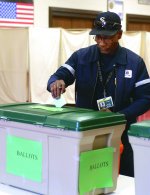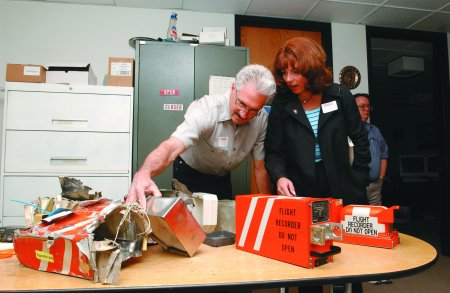|
|
Snow Job: CEO Taps into Treasury Well, not quite. Before departing CSX, Snow credited himself with an extra 19 years of service, boosting his annual pension to $2.5 million - rather than the meager $1.4 million a year he would have received before the pension perk was added. Snow cushioned his departure further with $8.1 million in cash, $8.7 million in deferred compensation and $18.9 million in stock, for a total exit package of $68.9 million! Snow leads a list of richly compensated railroad CEO's, including David Goode of Norfolk Southern ($12 million) and Richard Davidson of Union Pacific ($16.2 million). As Treasury Secretary under President Bush, John Snow is part of an administration calling for legislation to allow corporations to implement ‘cash balance' pensions for employees, a move that could cut benefits for older workers by fifty percent. Meanwhile, new contracts for IAM members at CSX remain stalled after three years, despite repeated calls for a formal release from negotiations.
The stakes for the
airline and its 75,000 employees could not have been higher, with a
bankruptcy judge poised to abrogate labor agreements and skittish
lenders threatening to withdraw critical financing. Armed with ratified agreements from all of its unions, United now faces a better-than-even chance to successfully restructure and emerge from bankruptcy. The industry-wide revenue, capacity and management crisis continues to threaten all carriers, but the situation will not be 'helped' by the liquidation of the nation's second largest airline. United is on track to follow US Airways, which exited bankruptcy following labor- savings pacts approved by Machinists there in January. "Airline employees everywhere are standing up to incredible challenges," said Transportation General Vice President Robert Roach, Jr. "Including threats from raider groups bent on destroying legitimate, democratic unions."
Surrounded by overflowing workbenches and testing gear at the National Transportation Safety Board (NTSB), investigators combine a detective's instincts with an encyclopedic knowledge of metallurgy and aeronautics to find the causes of more than 2,000 aircraft accidents each year. "This is where the bits and pieces are brought," said Derek Nash, an NTSB mechanical engineer who recently guided 32 IAM Air Transport members through the agency's Materials Laboratory in Washington, D.C. "We spend a lot of time looking for metal fatigue," explained Derek, holding up a fractured cylinder head from a radial engine. "Sometimes it's obvious and sometimes its quite invisible to the naked eye." In another workshop, a slow-motion 3D computer simulation provided a chilling display of one aircraft's losing battle with gravity. The simultaneous transcript of the actual Cockpit Voice Recorder (CVR) caused a poignant moment of silence for the IAM group. "The information from voice and flight data recorders is a critical part of any accident investigation," explained Aerospace engineer Anna Cushman. A nearby workbench filled with demolished recorders provided mute testimony to the force and violence of an aircraft accident. "We receive an average of two recorders each week,"said Cushman. "Transcribing a 30-minute recording can take from one day to three weeks." Flight data recorders provide precise readings of an aircraft's speed and function, but voice recordings are often difficult to interpret. "The words 'on' and 'off' can sound quite similar in a recording filled with static and other cockpit noise,"explained Cushman. The group visited NTSB Headquarters as part of a week-long curriculum developed by the IAM Safety & Health Department in response to requests for specialized training from delegates to the 2001 IAM Transportation Conference.
|



